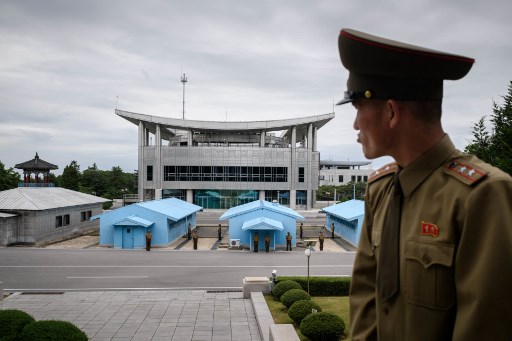
On the world’s last Cold War frontier, North and South Korean troops have long faced off against each other at Panmunjom, the truce village in the Demilitarised Zone that divides the two Koreas. Now the North Korean troops stationed there express hopes for June 12 unprecedented summit between their commander-in-chief Kim Jong Un and US President Donald Trump. / AFP PHOTO
by Ed JONES
Agence France Presse
PANMUNJOM, North Korea (AFP) — On the world’s last Cold War frontier, where troops have long faced off at the truce village that divides the two Koreas, propaganda broadcasts have fallen silent and soldiers from the North are hopeful a historic summit will herald a new era for their country.
The blue huts of Panmunjom are emblematic of the truce that stopped the fighting in the Korean War, and a favored destination for visiting US leaders looking to demonstrate their resolve to face down the North.
But now the North Korean soldiers stationed there express enthusiasm for Tuesday’s unprecedented meeting between their commander-in-chief Kim Jong Un and US President Donald Trump.
“In the past, we’ve held negative feelings against the troops on the other side,” Lieutenant Colonel Hwang Myong Jin told AFP.
“But for those who treat us with goodwill and want to improve relations, we can become friends and walk the same path holding hands despite our history.”
Hwang said he had a “positive stance” towards the talks in Singapore, where Kim clasped hands with Trump in a momentous encounter.
“Our republic has been squeezed in between the great powers in the past… But today, we are showing our dignity as an independent nation in front of the whole world.”
He keenly pointed out the pine tree planted by his leader and the South’s President Moon Jae-in during their first summit in April, when the pair swapped briefing papers for shovels to toss soil — from mountains in both countries — over its roots in one of several memorable moments.
“At first I was very nervous,” about the summit, he said. “Our Supreme Leader was crossing over to the dangerous Southside.”
But when Kim held hands with Moon to lead him to the northern side and back again, he added, “I thought the day of reunification was coming near.”
‘Sign their surrender’
But such sentiments are a recent phenomenon.
North Korea proclaims itself to have won the 1950-53 conflict, which it calls the Great Fatherland Liberation War.
A large stone plaque on its side of the DMZ commemorates a 2012 visit by Kim, who “gave us a valuable lesson that this is a historic place where the US invaders kneeled before our people to sign their surrender”.
“Our future generations will live in a reunified motherland,” it cites him as declaring.
The North constantly reiterates the importance of reuniting the peninsula, divided by the US and Soviet Union in the closing days of the Second World War, and its 1950 invasion was an attempt to do so by force.
Since then the democratic, capitalist South has accelerated into the economic distance, rising to become the world’s 11th-largest economy.
In contrast, the North was hammered by the collapse of the Soviet Union and has been subjected to multiple UN Security Council sanctions over its weapons ambitions.
On a previous visit to the DMZ, AFP’s then escort said that the “true nature” of the US was that it “gets in the way of peace”.
“As a soldier,” that officer added, “I only think about pushing the US out of the south as soon as possible and unifying our nation.”
In Pyongyang, a display board outside the main train station which has long featured images of military exercises and missile launches showed photos of infrastructure and agricultural projects.
But in the lobby bookshop of the main Yanggakdo tourist hotel, postcards showing anti-US propaganda were still displayed in a window, with images of missiles aimed at North America.
© Agence France-Presse







